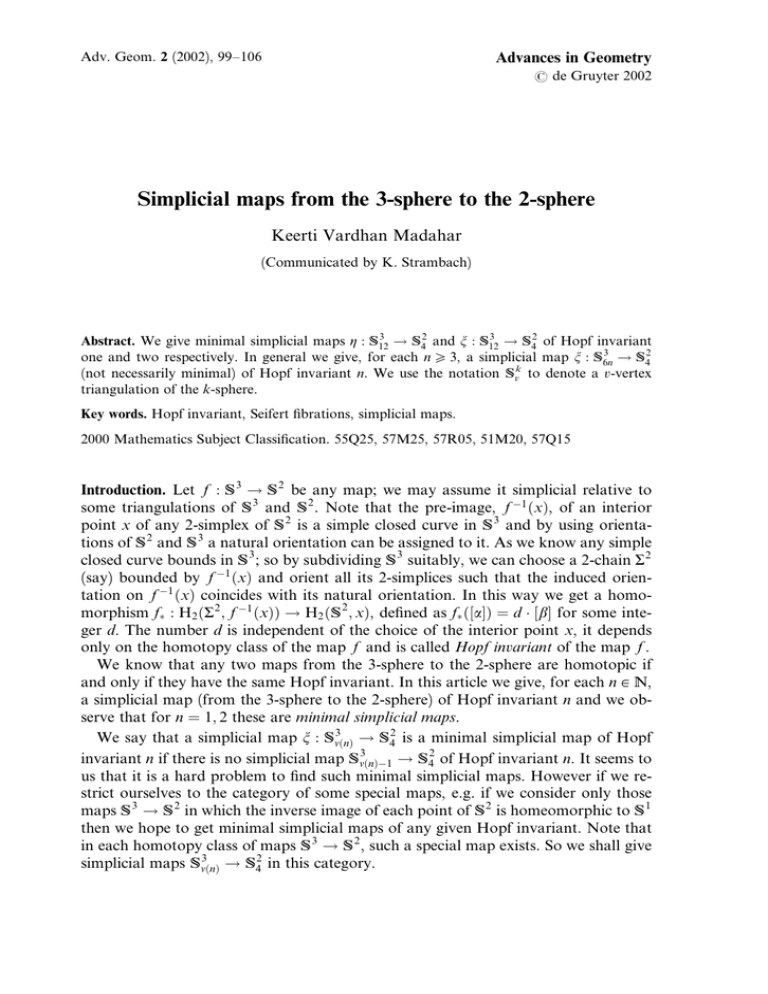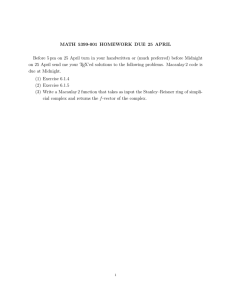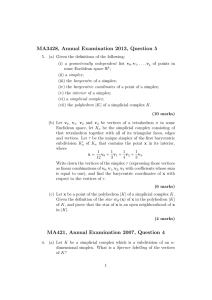Simplicial maps from the 3-sphere to the 2-sphere Keerti Vardhan Madahar
advertisement

Adv. Geom. 2 (2002), 99–106 Advances in Geometry ( de Gruyter 2002 Simplicial maps from the 3-sphere to the 2-sphere Keerti Vardhan Madahar (Communicated by K. Strambach) 3 3 Abstract. We give minimal simplicial maps h : S12 ! S42 and x : S12 ! S42 of Hopf invariant 3 one and two respectively. In general we give, for each n d 3, a simplicial map x : S6n ! S42 k (not necessarily minimal) of Hopf invariant n. We use the notation Sv to denote a v-vertex triangulation of the k-sphere. Key words. Hopf invariant, Seifert fibrations, simplicial maps. 2000 Mathematics Subject Classification. 55Q25, 57M25, 57R05, 51M20, 57Q15 Introduction. Let f : S 3 ! S 2 be any map; we may assume it simplicial relative to some triangulations of S 3 and S 2 . Note that the pre-image, f 1 ðxÞ, of an interior point x of any 2-simplex of S 2 is a simple closed curve in S 3 and by using orientations of S 2 and S 3 a natural orientation can be assigned to it. As we know any simple closed curve bounds in S 3 ; so by subdividing S 3 suitably, we can choose a 2-chain S 2 (say) bounded by f 1 ðxÞ and orient all its 2-simplices such that the induced orientation on f 1 ðxÞ coincides with its natural orientation. In this way we get a homomorphism f : H2 ðS 2 ; f 1 ðxÞÞ ! H2 ðS 2 ; xÞ, defined as f ð½aÞ ¼ d ½b for some integer d. The number d is independent of the choice of the interior point x, it depends only on the homotopy class of the map f and is called Hopf invariant of the map f . We know that any two maps from the 3-sphere to the 2-sphere are homotopic if and only if they have the same Hopf invariant. In this article we give, for each n A N, a simplicial map (from the 3-sphere to the 2-sphere) of Hopf invariant n and we observe that for n ¼ 1; 2 these are minimal simplicial maps. 3 We say that a simplicial map x : SnðnÞ ! S42 is a minimal simplicial map of Hopf 3 invariant n if there is no simplicial map SnðnÞ1 ! S42 of Hopf invariant n. It seems to us that it is a hard problem to find such minimal simplicial maps. However if we restrict ourselves to the category of some special maps, e.g. if we consider only those maps S 3 ! S 2 in which the inverse image of each point of S 2 is homeomorphic to S 1 then we hope to get minimal simplicial maps of any given Hopf invariant. Note that in each homotopy class of maps S 3 ! S 2 , such a special map exists. So we shall give 3 simplicial maps SnðnÞ ! S42 in this category. 100 Keerti Vardhan Madahar Indeed we are going to triangulate a particular type of the Seifert fibrations [3] of the 3-sphere. We know that any Seifert fibration of S 3 gives a quotient map S 3 ! S 2 (see [3]) under which a circle maps to a point and at most two points of S 2 can be exceptional and all other points are ordinary. But in our constructions at most one point of S 2 will be exceptional. We first recall definitions of ordinary and exceptional points of S 2 for a given quotient map S 3 ! S 2 having only one exceptional point. Ordinary points. Let f : S 3 ! S 2 be a map in which f 1 ðxÞ is homeomorphic to S 1 for all points x of S 2 and let D 2 denote the unit 2-disk in R2 with centre at the origin. We say x A S 2 is an ordinary point or a regular point if there exists a neighbourhood Ux J S 2 of x, and homeomorphisms h f 1 ðUx Þ ! D 2 S 1 ? ? ? ? ?f ?p y y h~ ! Ux D2 h : f 1 ðUx Þ ! D 2 S 1 and h~ : Ux ! D 2 with h~ðxÞ ¼ 0 for which the above diagram commutes. Exceptional points. Let r : D 2 ! D 2 be a rotation map defined as rðr e iy Þ ¼ r e iðyþ2p=nÞ for some n d 2. Consider the quotient space, Gn , obtained from D 2 I by identifying the points ðx; 0Þ with ðrðxÞ; 1Þ for all x A D 2 . This identification gives a quotient map qn : D 2 I ! Gn under which exactly n fibers, i.e. x I , rðxÞ I , r 2 ðxÞ I ; . . . ; r n1 ðxÞ I (here x 6¼ 0), of D 2 I , together form a single circle of Gn and the fiber 0 I of D 2 I maps to the middle circle of Gn . Let a map h : D 2 ! D 2 be defined as hðzÞ ¼ z n for some n d 2. Then there is a unique map g : Gn ! D 2 which makes the following diagram commutative. q D 2? I ! G ?n ? ? ?p ?g y y D2 h ! D 2 We call a point x of S 2 an exceptional or a singular point of multiplicity n, for a given map f : S 3 ! S 2 , if for each neighbourhood Ux of x there are homeomorphisms h : f 1 ðUx Þ ! Gn and h~ : Ux ! D 2 with h~ðxÞ ¼ 0 which make the following diagram commutative. h f 1 ðUx Þ ! Gn ? ? ? ? ?f ?g y y Ux h~ ! D 2 A fiber corresponding to an exceptional point will be called an exceptional fiber. Simplicial maps from the 3-sphere to the 2-sphere 101 3 Theorem. There exist minimal simplicial maps h; x : S12 ! S42 of Hopf invariants one and two respectively, and in general for each n > 2 there is a simplicial map 3 x : S6n ! S42 of Hopf invariant n. 3 Proof. A simplicial map h : S12 ! S42 has been shown and defined by the vertex labelling in Figures 1 and 2. Figure 1. T92 ¼ qM93 and M93 We have proved in [2] that the map h is the minimal triangulation of the well-known Hopf fibration h : S 3 ! S 2 , so the map has Hopf invariant one. Now we shall give a 3 minimal simplicial map x : S12 ! S42 of Hopf invariant two. Construction of a minimal simplicial map of Hopf invariant two. As we wish to make simplicial maps in which the pre-image of each point of S42 (it is the minimal triangulation of the 2-sphere) is homeomorphic to S 1 , so corresponding to four vertices of S42 there are four simplicial circles in S 3 and each will have at least three vertices. So at least 12 vertices are needed in S 3 to make a simplicial map of any non-zero Hopf invariant. Moreover it is interesting to know that any simplicial map Sv3 ! S42 , with v c 11, is a homotopically trivial map (see Theorem IIa of [1]). 3 3 The simplicial map x : S12 ! S42 F q[ABCD]. Our simplicial complex S12 is the union 3 of two solid tori. One of them, M9 , is the pre-image of a 2-simplex ABC. Its triangulated boundary has been shown in Figure 3 below. This solid torus consists of nine 102 Keerti Vardhan Madahar 3 3 Figure 2. T92 ¼ qN12 and N12 Figure 3. T92 ¼ qM93 and M93 Simplicial maps from the 3-sphere to the 2-sphere 103 3 3 Figure 4. T92 ¼ qN12 and N12 3-simplices, three of them are A0 B 0 C 0 B1 , A0 A1 B1 C 0 , A1 B1 C1 C 0 and the remaining six can be obtained from these by using the permutation a ¼ ðA0 A1 A2 ÞðB 0 B1 B 2 Þ ðC 0 C1 C 2 ÞðD 0 D1 D2 Þ. 3 The second solid torus, N12 , is the pre-image of S42 nInt: ABC. Its triangulated boundary (shown in Figure 4 above) is isomorphic to, and will be identified with, the boundary of M93 . It has thirty-six 3-simplices, twelve of them are A0 C 0 C 2 D 0 , A1 A2 C1 D 0 , A1 A2 B 2 D 0 , A2 B 0 B 2 D 0 , B 0 B 2 C 2 D 0 , B 0 C 0 C 2 D 0 , A0 B1 D 0 D1 , B1 C1 D 0 D1 , A1 C1 D 0 D1 , A1 B 2 D 0 D1 , B 2 C 2 D 0 D1 , A0 C 2 D 0 D1 and the remaining twenty-four can 3 be obtained from these by using the permutation a. Note that the solid torus N12 is homeomorphic to G2 under a fiber preserving homeomorphism, its middle fiber x1 ðDÞ is exceptional of multiplicity 2. 3 The simplicial map x : S12 ! S42 given by Xi 7! X for all X A fA; B; C; Dg is well 3 defined, as under this map simplices of S12 get mapped onto the simplices of S42 . 3 Remarks. 1. The solid torus N12 contains pre-images of CAD, ABD and BCD. We 104 Keerti Vardhan Madahar Figure 5 have given simplices of x1 ðCADÞ, in Figure 5, explicitly and simplices of x1 ðABDÞ and x1 ðBCDÞ can be obtained similarly. The simplicial complex x1 ðCADÞ consists of twelve 3-simplices, four of them are A0 C 0 D 0 D2 , A0 A1 C 0 D2 , A1 C 0 D1 D2 , A1 C 0 C1 D1 and the remaining eight can be obtained from these by using the permutation a. 2. From here it is very clear that pre-images of AD, BD and CD are Möbius strips bounded by x1 ðAÞ, x1 ðBÞ and x1 ðCÞ respectively. In each case the middle circle of the Möbius strip is x1 ðDÞ. Further note that pre-images of AB, BC and CA are cylinders. 3. Here vertices A, B, C are ordinary vertices while the vertex D is an exceptional vertex of multiplicity 2. So in order to verify the Hopf invariant of the map x, we 3 choose a 2-chain, in S12 , bounded by one of the pre-images of A, B or C and see the restriction of the map x to this 2-chain. In particular let us see in Figure 6 the restriction of x to a 2-chain bounded by the pre-image of the vertex A of S42 . It is clear from Figure 6 that the restricted map x : ðS 2 ; x1 ðxÞÞ ! ðS 2 ; xÞ has degree G2, so the Hopf invariant of the map is G2 depending upon the choice of the orientations of S 3 and S 2 . 3 Now we shall give for each n d 3, a simplicial map x : S6n ! S42 of Hopf invariant n but their minimality is yet to be verified. Simplicial maps from the 3-sphere to the 2-sphere 105 Figure 6 Figure 7 3 In order to make a simplicial map x : S6n ! S42 of Hopf invariant n d 3, we take 3 a sphere S6n which is the union of two solid tori (M and N say) whose common boundary is shown in Figure 7 above. 106 Keerti Vardhan Madahar The solid torus M has been triangulated with 3ð2n 1Þ 3-simplices. Three of them are A0 B 0 C 0 B1 , A1 B1 C1 C 0 , A0 A1 B1 CQ 0 and rest of the 3-simplices can be obtained from these by using the permutation a ¼ X A fA;B;C;Dg ðX0 X1 . . . X2n2 Þ. The second solid torus has been triangulated with 3ð2n 1Þð3n 2Þ 3-simplices; 3ð3n 2Þ of these are Ci Ai Aiþ1 D 0 , Ai Aiþ1 Biþ1 D 0 , Aiþ1 Biþ1 Biþ2 D 0 , Biþ1 Biþ2 C iþ1 D 0 , Biþ2 C iþ1 C iþ2 D 0 , C iþ1 C iþ2 Aiþ2 D 0 , A0 B1 D 0 D1 , B1 C1 D 0 D1 , A1 C1 D 0 D1 , Ai Biþ1 D 0 D1 , Biþ1 C iþ1 D 0 D1 , C iþ1 Aiþ2 D 0 D1 for each odd i A Z=ð2n 1Þ i.e. i lies in the set f1; 3; 5; . . . ; 2n 3g and the rest of the 3-simplices can be obtained from these by 3 using the permutation a. It is easy to verify that the simplicial map x : S6n ! S42 defined as Xi ! X for all X A fA; B; C; Dg has Hopf invariant n. Acknowledgement. The author is grateful to Prof. K. S. Sarkaria for suggesting the problem and to Prof. W. Kühnel for invaluable suggestions which improved the presentation of the paper. References [1] S. Eilenberg, On continuous mappings of manifolds into spheres. Ann. of Math. (2) 41 (1940), 662–673. MR 2,71d Zbl 0024.19102 [2] K. V. Madahar, K. S. Sarkaria, A minimal triangulation of the Hopf map and its application. Geom. Dedicata 82 (2000), 105–114. MR 2001k:57031 Zbl 0965.57021 [3] H. Seifert, W. Threlfall, A textbook of topology. Academic Press Inc. 1980. MR 82b:55001 Zbl 0469.55001 Received 9 November, 2000 K. V. Madahar, Mathematics Department, Panjab University—Chandigarh, India, 160014 Email: keerti_r@lycos.com





